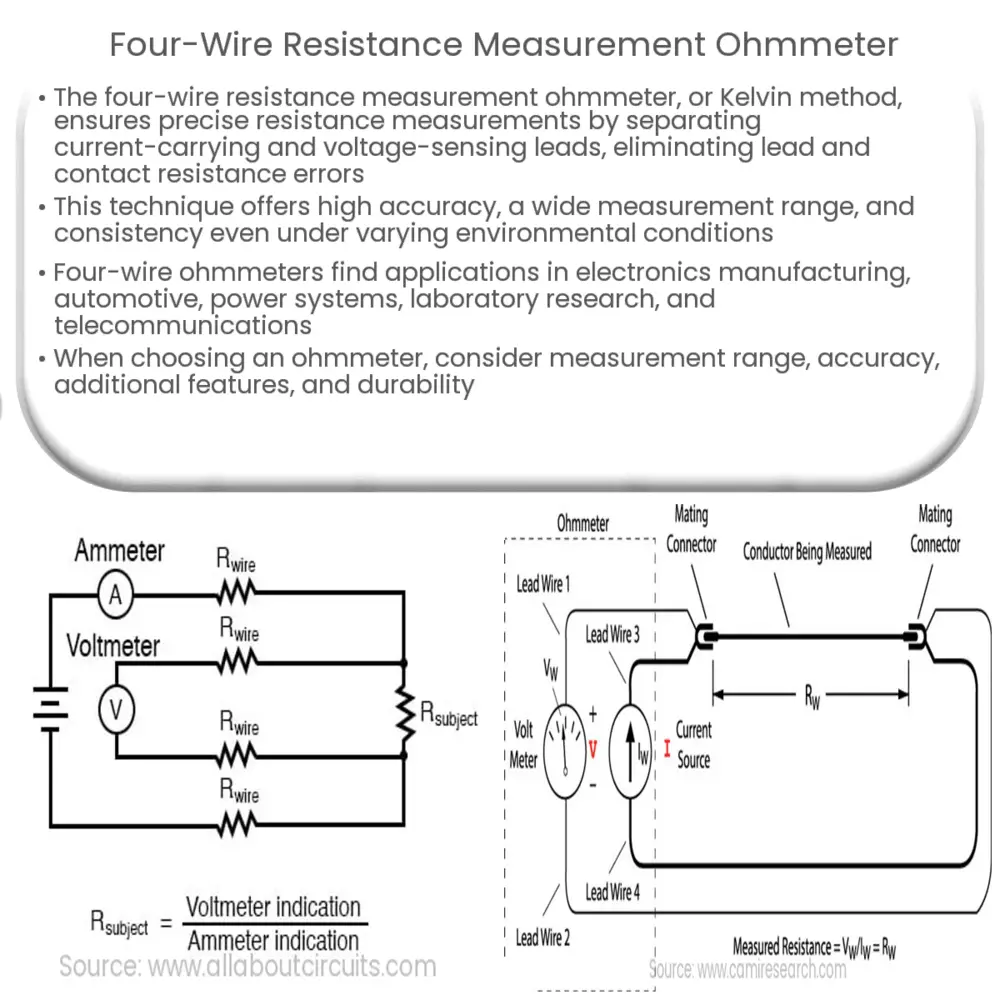The four-wire resistance measurement ohmmeter offers accurate resistance readings, eliminating errors caused by lead/contact resistance, ideal for various industries.

Four-Wire Resistance Measurement Ohmmeter: An Overview
Introduction
Accurate resistance measurements play a crucial role in various industries and scientific applications. The four-wire resistance measurement ohmmeter is a widely used technique for ensuring precise measurements, even in the presence of lead resistances and contact resistances. In this article, we will explore the principles behind the four-wire measurement technique, its advantages, and applications in different fields.
Principles of Four-Wire Resistance Measurement
The four-wire resistance measurement, also known as the Kelvin or four-terminal sensing method, is based on the concept of separating current-carrying and voltage-sensing leads. The technique uses two pairs of leads, one pair for passing a constant current through the resistor under test, and the other pair for measuring the voltage drop across the resistor. This separation eliminates errors caused by lead resistance and contact resistance, providing an accurate resistance measurement.
The ohmmeter passes a constant current (I) through the resistor using the current-carrying leads (source and sink). At the same time, the voltage-sensing leads (positive and negative) measure the voltage drop (V) across the resistor. Ohm’s law (R = V/I) is then used to calculate the resistance of the resistor under test.
Advantages of Four-Wire Resistance Measurement
- Accuracy: The four-wire measurement technique is highly accurate, as it eliminates errors caused by lead resistance and contact resistance. This is especially important for low-resistance measurements, where even small errors can lead to significant inaccuracies.
- Wide Range: The four-wire ohmmeter can measure resistances across a wide range, from milliohms to megaohms. This makes it suitable for various applications, from semiconductor testing to high-voltage power systems.
- Consistency: The four-wire technique ensures consistent measurements, even when the contact resistances or lead resistances change due to environmental factors such as temperature or humidity.
Applications of Four-Wire Resistance Measurement Ohmmeters
The four-wire resistance measurement ohmmeter is used in various industries and scientific fields, including:
- Electronics Manufacturing: In the electronics industry, four-wire ohmmeters are used for testing components, such as resistors, capacitors, and inductors, to ensure their specifications meet the required standards. They are also employed in quality control and failure analysis processes.
- Automotive: In the automotive sector, accurate resistance measurements are crucial for determining the performance of sensors, wiring harnesses, and other electrical components. Four-wire ohmmeters are used to test and verify these components during the manufacturing process and for troubleshooting in the field.
- Power Systems: Four-wire resistance measurement is essential for the testing and maintenance of high-voltage power systems, such as transformers, circuit breakers, and busbars. Accurate resistance measurements ensure the proper functioning of these critical components, preventing system failures and enhancing safety.
Laboratory Research and Calibration
In laboratory settings, four-wire resistance measurement ohmmeters are used for various research applications and calibration processes. The high accuracy and precision of these devices make them ideal for characterizing materials, measuring the temperature coefficients of resistance, and determining the resistivity of thin films or other materials. They are also commonly used for calibrating standard resistors and other measurement devices.
Telecommunications
In the telecommunications industry, four-wire resistance measurement ohmmeters are used to test and maintain the integrity of communication cables and connectors. Accurate resistance measurements are crucial for ensuring signal quality and minimizing transmission losses. These devices help technicians identify faulty cables or connectors, allowing them to be repaired or replaced, thus maintaining the reliability of communication networks.
How to Choose a Four-Wire Resistance Measurement Ohmmeter
When selecting a four-wire resistance measurement ohmmeter, there are several factors to consider, including:
- Measurement Range: Choose an ohmmeter with a measurement range suitable for your specific applications. This may vary from milliohms to megaohms, depending on the types of resistors and components being tested.
- Accuracy and Resolution: Consider the required accuracy and resolution for your application. Higher accuracy and resolution may be necessary for critical measurements or research purposes, while lower accuracy may be sufficient for routine testing and maintenance tasks.
- Additional Features: Some four-wire resistance measurement ohmmeters include additional features, such as temperature compensation, data logging, or built-in calibration capabilities. Determine if these features are important for your specific needs and select a device accordingly.
- Price and Durability: Consider your budget and the durability of the device. High-quality, durable instruments may be more expensive, but they often provide better long-term value and performance.
Conclusion
The four-wire resistance measurement ohmmeter is an essential tool for various industries and scientific applications, providing accurate and consistent resistance measurements across a wide range of resistances. Its ability to eliminate errors caused by lead resistance and contact resistance makes it the go-to method for many applications, from electronics manufacturing and automotive testing to power systems and laboratory research. When selecting a four-wire ohmmeter, it is important to consider factors such as measurement range, accuracy, resolution, and additional features to ensure the device meets the specific needs of your applications.

